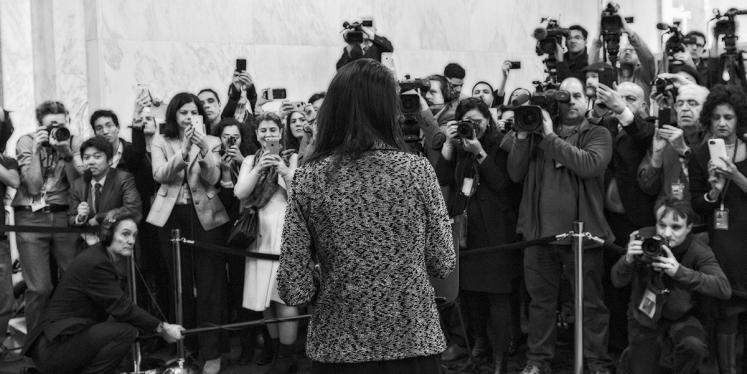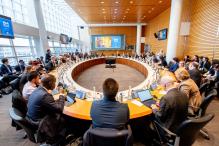How do multilateral systems collapse? It is a question that will have occurred to anyone who watches the United Nations or other global institutions in recent years. The Security Council has failed to manage the horrific wars in Syria and Yemen. International trade talks have gone through extended periods of inertia. The Group of Twenty (G20), which leapt to prominence during the 2008 financial crisis, has not become the steering committee for global affairs that initially seemed possible. The United States, which had become the de facto guarantor of the international order, now has a president who questions the value of international institutions on a weekly basis. Washington has pulled out, or announced plans to quit, UN bodies such as the Human Rights Council and arrangements including the Paris climate change deal. Common sense suggests that multilateral diplomacy should now be in freefall.
Yet reports of the death of international cooperation appear to be exaggerated, at least for now.
US disengagement aside, the three most noteworthy features of multilateral diplomacy in the last few years have been slightly reassuring. Firstly, a majority of states have responded to the Trump administration’s attacks on international mechanisms by increasing their support for them. No other country has followed Washington out of the Paris agreement. Secondly, there is still some room for innovation in multilateral affairs: the UN’s members have just signed off on a new Global Compact on Migration (GCM) despite America’s decision not to participate in the process. Thirdly, operational arms of the multilateral system continue to function despite facing extreme levels of strain in crises, albeit highly imperfectly. UN peacekeeping forces have not been able to halt violence in Mali or South Sudan, but there has been no general collapse of blue helmet missions comparable to that which followed the Rwandan and Balkan disasters in the mid-1990s. The flow of refugees from Syria came close to overwhelming relief agencies completely in 2015, but they have managed to struggle on.
There is no case for complacency. Keeping multilateral diplomacy and operations alive has involved enormous compromises. Recent major international agreements, from the Paris deal to the GCM, have been legally non-binding bargains rather than formal treaties. It is not clear that they have the heft to confront other immense challenges like global warming and mass movements of people. It is possible that future generations will conclude that the 2010s were a decade of international footling, with diplomats settling on lowest common denominator agreements that were insufficient to address worldwide threats. Similarly, the recent resilience of UN peacekeepers and agencies such as UNHCR will ultimately count for little if, as is quite possible, the years ahead see more and bigger wars and refugee crises.
The historical record shows that international systems do not necessarily implode all at once. It is possible for states and institutions to pursue successful multilateral processes while the world is falling apart around them. As Zara Steiner notes in her monumental history of the 1930s, The Triumph of the Dark, the League of Nations remained busy and useful as war approached. The Health Organization (precursor to today’s World Health Organization) and International Labour Organization made serious contributions to spreading new standards in medicine and industrial legislation. The economic arm of the organization backed up international cooperation on navigating the depression. In doing so, the League laid the foundations for further progress by the UN in these fields and others after 1945. Yet, as Steiner notes, “during the later 1930s the League was perceived to be, and indeed simply was, a failure” because of its basic failure to manage the threat posed by Nazi Germany and Axis powers.
Historical comparisons have their limits. Although bleak, the international security picture is still far less dire than it was in the 1930s. Today’s multilateral system is also vastly more developed than the nascent mechanisms of the inter-war period. Nonetheless, it is best to view the current multilateral scene with a 50/50 mix of optimism and pessimism. On the upside, the system is enduring the current period of disorder better than many analysts presume. On the downside, we know that even successful strands of cooperation can unravel if deeper geopolitical shifts render them irrelevant.
Power structures
An underlying challenge for anyone who cares about multilateralism is, therefore, to try to understand how the basic structure of global power will undercut or reshape current mechanisms of cooperation. In this regard, the current moment is far more complex than the 1930s. The mismatch between power realities and the structure of the League was blindingly obvious. The US stayed outside the League – although it did participate in its comparatively successful economic track – and Germany and Japan stormed out of it. By contrast, both the US and revisionist powers remain inside the current system. The Trump administration may have pulled out of a few parts of the UN, but it is unlikely to quit the Security Council any time soon (although well-informed observers believe it could exit NATO and/or the World Trade Organization, which would be as bad or worse internationally).
China, meanwhile, has recently upped its investments in the UN and international economic cooperation, aiming to take a leadership role on issues from climate change to peacekeeping. Russia may have clashed with the US and its allies over Syria and other crises in the Security Council, but Moscow still has a strong interest in keeping UN diplomacy alive due to its leverage in New York.
Multilateral institutions are platforms for the major powers to tussle for influence, and for other states to try to influence the biggest beasts. (The Trump administration may eventually find that stepping out of these processes simply cedes influence to others without the tussle.) This is not likely to increase their efficiency. If the level of competition between states in multilateral fora increases, the quality of lowest common denominator agreements is likely to fall even further, as compromises become harder. This tendency helps explain the trend towards broad and non-binding agreements at the UN on major issues we have already witnessed. The price of keeping the multilateral system going is often to set limits on what it can do.
Three conceptual challenges
For those who would like the system to keep doing worthwhile things (UN officials and so forth) the main policy challenge is, therefore, to make the most of the limited processes and bargains they have available. This involves three main conceptual challenges.
The first conceptual challenge is to work out how to forge the best compromises feasible among states in future diplomatic processes. The rise of China and general redistribution of global power will continue to make negotiations more complex, and diplomats and UN officials need to draw lessons from processes like the climate talks on how to get decent deals.
The second dimension is how to ensure weak deals are genuinely implemented. In the wake of the conclusion of the Paris agreement and Sustainable Development Goals (SDGs), there have been lengthy discussions of how to deliver and measure progress on the broad commitments involved. There are already worrying signs of slippage on the SDGs. Multilateral organizations are still learning how to frame “soft” agreements in ways that inspire states and non-state actors to take action on them.
The third, and deepest, conceptual challenge is how to hedge against new geopolitical shocks undercutting this painstaking diplomatic work. These shocks could come in many forms, ranging from a sudden conflict involving one or more major powers to even more drastic attacks by the US on multilateral institutions. This raises uncomfortable political questions: can concerned actors in multilateral institutions – such as the UN Secretary-General and elected members of the Security Council – do anything to pre-empt and prevent such strategic surprises? How will international crisis management have to change in a world of open-ended major power competition? If relations between the big powers deteriorate sharply, short of actually descending into outright war, how can multilateral arrangements and institutions be preserved by other parties?
These are some of the themes that I hope to pursue in future writings for the United Nations University Centre for Policy Research, where I have recently joined. Hopefully a lot of multilateral officials and diplomats are asking themselves similar questions. The collapse of the multilateral system is not necessarily imminent or even likely. But it is a good moment to prepare for the worst.
Suggested citation: Richard Gowan., "Multilateralism in Freefall?," UNU-CPR (blog), 2018-07-30, https://unu.edu/cpr/blog-post/multilateralism-freefall.




